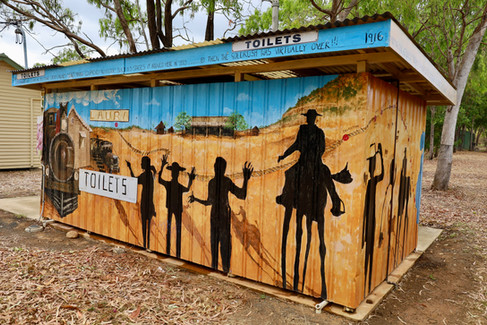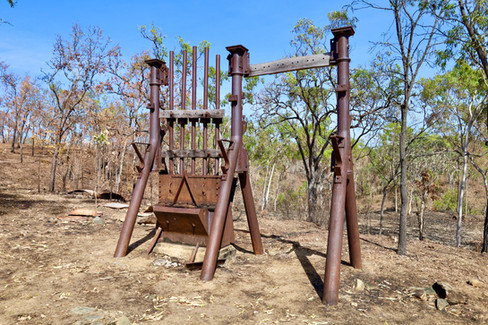Survival Story: The Treacherous Gold Hunt in Maytown, Cape York, QLD
- Woolgoolgaoffroad
- Jan 31, 2024
- 6 min read
Just imagine walking for two weeks into hospitable country where there was no food and little water, cannibals were known to be in the area, and not guaranteed to find gold, and this was after months on a boat from a different country or after travelling to northern Australia for weeks on foot.

Believe it or not, this is what prospectors faced back in the mid-1800s when they heard of new gold fields in Cape York, that would later become the richest in Australia.
Curiosity got the better of me after reading a book called “The Rivers of Gold” which portrayed the riches and hardships of thousands of prospectors who made their way to the area seeking fortune. I decided to head across to Cape York on a recent trip to try to understand the hardship and complete isolation that this area represented.

William Hann, an explorer and bushman found gold in the isolated hills 200km west of Cooktown in the Palmer River around 1874 and a year later a prospecting party found payable gold, word got out and the rush was on.
James Mulligan was an experienced and well-respected explorer who made his way to north Qld in the early 1870s to lead exploration parties into new areas to look for gold. He had amazing success and literally opened up the Palmer River Goldfields for other prospectors to hunt for their fortune. Mulligan was supported by the government through grants and rewards to open new areas such as the Hoskinson goldfields and work in other areas.

Heading the 200km out to the goldfields caused all sorts of issues such as lack of food ( Mulligan quoted ‘any man who heads out towards the Palmer with less than two weeks supply - will surely perish” ), the terrain was hospitable and then there was cannibalism, as several local tribes were known to be on the hunt.

When word got out, barges and ships from around the world started to arrive at Cooktown ( which started as a few tents on the banks of the Endeavour River ) and soon became a bustling port as the town grew immensely with the new arrivals.
Some reports say there were up to 47 licensed drinking premises, brothels, two newspapers, Chinese opium houses, bakers and official government houses. In a short amount of time, the town swelled with nearly 30,000 people passing through and heading out to the goldfields, and a majority of them were Chinese.

The Chinese had a strong presence through the goldfields and were much hated by other diggers as conflict was always breaking out, but they were much loved by the local cannibals for their sweet taste. Hardworking and quiet they did well on the Palmer through prospecting, establishing market gardens to supply the town and goldfields with fresh produce and rice. Even today there is a strong Asian influence in Cooktown.

With the goldfields swelling to capacity over time there was a constant hunt for new gold. Lone miners moved away from the crowded rivers and creeks only to find themselves hunted by the local tribes or their camps raided by other miners looking for free gold. The Palmer River Goldfields were some of the most isolated in the country with problems such as wet season flooding where bridges and tracks simply washed away, supplies often took weeks and lack of medical help meant plenty of deaths.
The goldfields were known to be great alluvial fields and diggers had the opportunity to get rich quickly. In fact when many prospectors found a good gold they went back to Cooktown to spread their wealth. Some miners drunk and threw gold at dancing girls, smart ones cashed in and left while others gathered more supplies and trudged back to the Palmer.

Now a railway line was proposed from Cooktown out to the now-established Maytown, but with the lack of workers and gold petering out the line was only built to Laura just 108 km away.
Today, massive bridge piers can be found near the Laura River, this section of the line is now called the track to nowhere, as it never reached Maytown. The heart of the Palmer River goldfields boomed but for only a short time as the gold became harder to find. Miners left and shopkeepers closed up and followed the miners to new fields.

Roll onto today and the Palmer River area is a quiet place apart from 4wders, prospectors with detectors and history buffs all seeking to explore the area. My journey into this historical area started at Laura, about 350km north of Cairns where it would be my last stop for fuel for several days.

Finding the turn to Maytown was as easy as heading down the maintained Palmerville Road until the Maytown sign, and onto the Old Coach Road which is regarded as one of the hardest and most challenging tracks in Cape York.

Straight from the start, the Old Coach Road was a challenge with steep drop-offs, rocky sections, continuous ruts that crisscrossed the road and an endless amount of rocks that covered much of the road.

Covering the 90 km took nearly 8 hours with the un-relenting rough and never-ending challenges. Sections of the road - well track really - were only as wide as my 4WD and often with a steep drop on one side and high cliffs on the other, this is one place not to meet other 4WDs.

Being there in the dry season there was still water in the Palmer and Old Palmer River which made for a nice break in the drive and panoramic views from the hills showed just how hard and hospitable this land is, never mind over 100 years ago walking here.

MAYTOWN
Maytown today is littered with an array of historical ruins like stone walls, and rusted and weathered pieces of metal but one of the main attractions has to be the cobblestone curb and walkways that can still be found made mainly from local slate.

The integrity of the laid rock is impressive all along the main street and some of the old shops have the same stonework right to where their doorway would be. It was good to see plaques indicating shop owners' names and their type of business along the street, and just nearby a replica miners' hut has been built and it's full of relics and memorabilia from the area.
I spent the day exploring the old mine sites where stampers, boilers and massive pieces of broken steel that have been shattered lay on the ground. Deep mines that were once a hive of activity now lay abandoned and are fenced off, info signs describe how hard mining life was due to the isolation and lack of water.
MINES
One of the most significant sites was the Comet Mill and mine. Part of the National Estate Register this site has now been persevered for the future as it is one of the largest intact original collections of 19th century mining gear.

The Comet was huge for its day with a massive boiler and 10-head stamper with 25 horse-powered engines. Unfortunately, water was an issue again with none during the dry season and then during the wet, the mine shafts were flooded.
Walking around I was amazed to see a lot of the gear stamped, made in Melbourne 1882, making my trip in here seem easy driving a modern 4WD.

Spending a few days exploring the Maytown story, camping on the beautiful Palmer River and tacking the Old Coach Road it was time to head out and further south. Crossing the river it's a good 80km drive back out towards the Palmer River Roadhouse along Whites Creek Road and civilisation.

Now like any good book that describes the conflicts, exploration and riches from days gone by, there may be some discrepancies between fact and fiction. But one thing I know is that the adventure and fables of Maytown are alive and well in this once hospitable gold rush area.
WHERE
Maytown and the Palmer River Goldfields are in Cape York in far north Queensland. Once known as Australia's largest and richest goldfields, it is now a remote, deserted, isolated region where a 4WD is necessary to explore. Nearly 600 km north of Cairns, there is plenty to see and do for the avid adventurer, gold hunter and historian.

WHAT TO SEE, DO AND EXPECT
This harsh region used to make or break good men, but today it's a go-to area in Cape York for gold hunters seeking some riches. The old coach road on the northern side of Maytown is a 4wders dream, where it's a full day drive to complete the 80km drive in. You’ll need a good 2-3 days in here to wander around the old town, find the mills and stampers and enjoy the serenity at the camps on the Palmer River. No services once you leave Laura so self-preparation is a must.
OTHER FACTS
It's a very remote part of Cape York and the Old Coach Road is regarded as a very hard track in the area. High clearance is needed and towing would be tough on the track from Maytown to Laura due to steep angles, very narrow cuttings and big ruts. The Cape York paper map is the best to use or a good GPS. Most tracks and points of interest are marked along the way. The old Maytown town site is a great place to spend a few hours wandering around looking at the relics. The best time of the year to go would be the cooler months and after the wet season has passed.



















































Comments